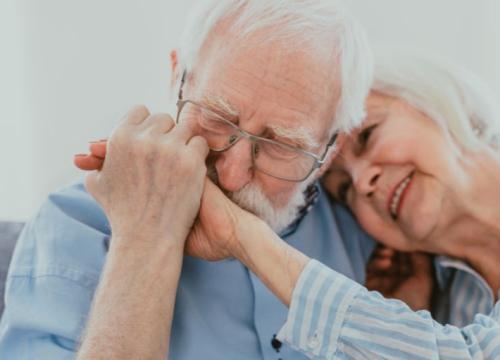How to Manage Bladder and Common Urinary Issues in Parkinson’s

Though bladder problems are one of the most common challenges in Parkinson’s disease (PD), they are rarely discussed with a doctor. Parkinson’s can impact bladder function in many ways, including urinary urgency, leakage and urinary tract infections. Untreated, some urinary issues can lead to cognitive problems. Discover why it’s important to discuss urinary difficulties with your healthcare provider and learn about the treatments that address challenges and improve quality of life.
This article is based on Parkinson's Disease and the Bladder, a Parkinson’s Foundation Expert Briefing webinar presented by Abhimanyu Mahajan, MD, MHS, Movement Disorders Neurologist and Assistant Professor of Neurology, University of Cincinnati and Ankita Gupta, MD, MPH, FACOG, Associate Fellowship Director, Female Pelvic Medicine & Reconstructive Surgery, University of Louisville Health.
PD and Pelvic Floor Health
In Parkinson's, the brain does not produce enough dopamine. The decrease in this feel-good brain chemical impacts more than movement and mood. Parkinson’s-related brain changes can lead to a host of symptoms in the pelvic floor region that can impact gastrointestinal and urinary systems, sexual health and more.
Constipation, common in PD, can begin as early as 20 years before the key movement symptoms that lead to a diagnosis. Urinary symptoms, however, often begin after someone has lived with Parkinson’s for 10 years or more.
Urinary and Bladder Issues
Parkinson’s impacts the autonomic nervous system (the system in charge of the body’s unconscious actions, such as pumping blood, blinking and breathing). When this system causes urinary issues, it’s known as neurogenic bladder dysfunction.
These urinary problems are widespread in Parkinson's and affect women and men. Whether doctors do not bring up urinary health or people are reluctant to mention issues, research shows that anywhere from 24% to 96% people with PD experience urinary symptoms.
Urinary challenges are also commonly associated with increased age and worsening cognitive function. The average age of a person receiving a Parkinson's diagnosis is 60 — around the same age people commonly experience:
- Urinary urge incontinence: urgency accompanied by leakage
- Stress incontinence: urine leakage when coughing, sneezing or exercising
- Mixed incontinence: leakage after a sensation of urgency and with physical movement
Unless asked, women are far less likely to report urinary challenges compared to men. When asked, almost 50% of all women in the U.S. more than 80 years old report at least one relevant urinary symptom.
In addition to urinary incontinence and leakage, PD can cause:
- difficulty initiating urination.
- failure to fully empty the bladder.
Risks Related to PD Urinary Symptoms
In Parkinson’s, the inability to delay urination can lead to falls.
Neurogenic orthostatic hypotension (nOH), when blood pressure drops when moving from sitting to standing, or from lying down to rising, can be common in people with PD and other nervous system disorders. Urinary urgency combined with nOH can increase a person’s fall risk.
PD-related balance difficulties (postural instability), trouble moving and walking and waking to use the bathroom at night — when Parkinson’s medications are not fully effective — can also increase the risk of falls connected to urinary urgency and bladder issues.
Sudden cognitive changes are unusual in PD. These should be urgently addressed and may be caused by a urinary tract or bladder infection, other infections, or a medication side effect.
Assess and Address Bladder Health
If you experience urinary issues, talk to your healthcare provider. To prepare:
- Keep a 24-hour overactive bladder diary. This can help you keep track of urination timing and frequency and provide greater detail to your doctor.
- Think about your treatment goals. Do you need enough relief to sleep better or are you hoping to get through an outing without overly frequent trips to the restroom?
- Aim to take PD medication on time, every time. Most people with PD know medication timing is often essential to controlling PD symptoms. Staying on schedule can also impact bladder function.
Your doctor may refer you to a specialist. Urologists are doctors who focus on the urinary system, while urogynecologists specialize in treating pelvic floor disorders in women.
Urinary Issue Treatments
Your doctor will try to get to the root of any urinary issues, looking for reversible causes such as an infection or diuretics (water pills). It’s not uncommon for people with Parkinson’s to have bladder symptoms that predate their PD diagnosis.
A doctor might have you stand or sit and cough to assess for stress incontinence or use an ultrasound or catheter to confirm whether your bladder is fully emptying. Urodynamic testing can help your healthcare provider determine whether your bladder fills and empties at normal pressures and reveal urinary dysfunction.
Treatment is tailored to a person’s symptoms and goals. Non-surgical options include:
- Kegel and pelvic floor muscle strengthening exercises, which can benefit men and women.
- Referral to pelvic floor physical therapy.
- Behavioral and lifestyle modifications, such as practicing urge suppression and urinating at fixed intervals to retrain the bladder and increase its holding capacity.
- Botulinum toxin injections for overactive bladder.
- For women, a continence-support pessary — a tailored, soft, vaginal device, typically removable, that can improve bladder control. This option may be challenging as Parkinson’s advances.
Medication therapy is also an option. Beta-3 agonists mirabegron (Moretti®) and vibegron (Gemtesa®) are once-a-day medications to control bladder urgency and frequency.
While anticholinergic drugs are often a first-line therapy for bladder issues, research finds cognitive slowing can be a side effect to these drugs. Use should be avoided in people older than 70, as there is a greater potential for anticholinergic-related hallucinations and confusion. Oxybutynin (Ditropan®), darifenacin (Enablex®), tolterodine (Detrol®), trospium (Sanctura®), phenoperidine fumarate (Toviaz®) and tofenacin succinate (VESIcare®) are among the anticholinergics used to manage overactive bladder.
Surgical options for bladder challenges include:
- Injection of a hydrogel urethral bulking agent. This acts as a plug to stop urine leakage during coughing, exercise or other movement.
- Sacral neuromodulation. Electrical stimulation through an implanted bladder pacemaker-like device, to improve urinary urgency, incontinence and retention.
- Urethropexy to adjust and support the urethra for bladder control.
- Retropubic colposuspension. Reinforcement for the bladder and urethra to improve urinary incontinence.
- For men, bladder sling surgery, which supports the urethra to boost bladder control.
- For women with stress incontinence, urethra-supporting synthetic midurethral sling surgery or autologous fascial sling surgery.
Learn More
Explore our resources about urinary issues and Parkinson’s:
- Fact Sheet: Urinary Problems in Parkinson's Disease
- Blog: Tips for Intimacy & Incontinence with Parkinson’s
- Web Page: Urinary Incontinence
Related Blog Posts

What's Hot in PD? Short and Long-Term Problems with Anticholinergic Drugs used for Sleep, Bladder, and Tremor Symptoms in Parkinson’s Disease Patients

Tips for Intimacy & Incontinence with Parkinson’s
